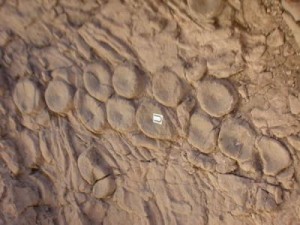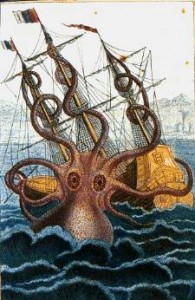 I’m so in love with this story I could practically explode.
I’m so in love with this story I could practically explode.
According to paleontologist Mark McMenamin from Mount Holyoke College not only is their a very real possibility that the mythological kraken once DID roam the seas, but at least one of the cephalopods may have even been self aware enough to have actually created the earliest known self portrait.
I know it sounds more than a little crazy right? But let me explain.
You see, for quite some time we’ve known about the huge ichthysosaurs that dominated the oceans during the Triassic Period. These tremendous beasts have been sitting perched at the top of the Triassic food chain since the first complete fossil was found in 1811.
Now if you’re a paleontologist and want to get a look at some real-live icthy bones chances are at some point you’ll trundle off to Nevada to Berlin-Ichthyosaur State Park where you will find the remains of nine of the 45-foot behemoths waiting for you….the largest specimens ever uncovered (the park actually boasts a total of 40 icthy finds).
But something has been puzzling dinosaur geeks about those nine sets of dino remains for probably fifty years now. There’s a real mystery surrounding them that they’ve never quite been able to figure out. It turns out that the way the nine sets of icthy bones are stacked so neatly together just doesn’t quite compute. The arrangement seems…well…anything but natural.
One theory, first proposed in the 1950’s by Charles Lewis Cam, is that the dinosaurs succumbed quite suddenly to a toxic plankton bloom. But recent testing has suggested that the site where the bones were found was more likely a deep water spot making the toxic-plankton theory highly unlikely.
And so with the dominate theory all but shot down researchers have been left once again scratching their heads over the peculiar bone arrangement. Well, that is until Mark McMenamin…who was interested in the shallow death versus deep death question…paid the park a visit. As he studied the bones he said that, “It became very clear that something very odd was going on there.” He noted that the varied etching of the bones spoke against the animals all having died at the same time. And the distinct arrangement of the bones seemed to indicate that they had purposefully been placed.
 So being the kind of braniac that he is McMenamin started giving some intense thought to that bone arrangement and a light bulb went off. He remembered that there IS one modern predator that’s known for the intelligent manipulation of bones…the braniac of the deep the modern octopus! And that’s when his kraken theory was born. McMenamin has proposed that there was in fact a huge ancient octopus just like the kraken of mythology that hunted ichthysosaurs, took their carcases to this spot, and neatly took them apart. And of course if there’s one kraken there are more.
So being the kind of braniac that he is McMenamin started giving some intense thought to that bone arrangement and a light bulb went off. He remembered that there IS one modern predator that’s known for the intelligent manipulation of bones…the braniac of the deep the modern octopus! And that’s when his kraken theory was born. McMenamin has proposed that there was in fact a huge ancient octopus just like the kraken of mythology that hunted ichthysosaurs, took their carcases to this spot, and neatly took them apart. And of course if there’s one kraken there are more.
And as if that amazing revelation somehow wasn’t exciting enough to tickle your fancy hold on to your hat because there’s more.
Within the neatly piled bones there’s another distinctly unnatural feature. A number of the vertebral disks from the long-gone dinosaurs have been arranged in a geometric pattern. The circular disks are nested together neatly in a double line appearing to have been arranged in an almost perfect representation of the sucker disks found on a cephalopod tentacle!
Yes, we may have actual evidence of self-aware art…a self-portrait no less…dating all the way back to the Triassic period and it was an animal that created it!
How freakin’ awesome is that?!?
P.S. – And sure there are naysayers who are using terms like “highly unlikely,” “improbable,” and even “fanciful” but personally I choose to believe because frankly the world is abetter place for having had krakens in it. Besides, it’s like Tinkerbell or Dumbo…it’s all about the believing.
[Photo:Â Courtesy Mark McMenamin]
[Diagram of the skeletal anatomy of Ichthyosaur communis by William Conybeare 1824]
[Kraken pen and wash by Pierre Dénys de Montfort 1801)






